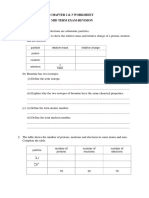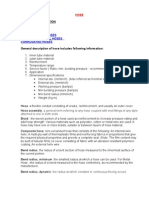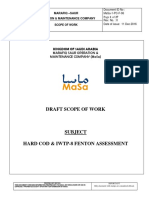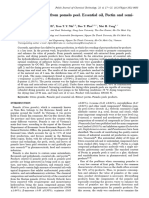Ows Hand Out
Ows Hand Out
Uploaded by
John Carl Ambrocio CorpuzCopyright:
Available Formats
Ows Hand Out
Ows Hand Out
Uploaded by
John Carl Ambrocio CorpuzOriginal Title
Copyright
Available Formats
Share this document
Did you find this document useful?
Is this content inappropriate?
Copyright:
Available Formats
Ows Hand Out
Ows Hand Out
Uploaded by
John Carl Ambrocio CorpuzCopyright:
Available Formats
OILY WATER SEPARATOR
It is a 15 PPM equipment onboard ships used to discharge bilge water in accordance with
MARPOL Annex 1. It separates oil from oily water mixtures and from emulsions. Oily water separator
is used on ship to prevent the discharge of oil overboard mainly when pumping out Bilges.
Oil filtering equipment referred to in regulations 14.1 and 14.2 is a 15 ppm bilge separator and
may include any combination of a separator, filter or coalescer and also a single unit designed to
produce an effluent with oil content not exceeding 15 ppm.
Any discharge into the sea of oil or oily mixtures from ships of 400 gross tonnage and above shall be
prohibited except when all the following conditions are satisfied:
1. The ship is proceeding en route; .
2. The oily mixture is processed through an oil filtering equipment.
3.The oil content of the effluent without dilution does not exceed 15 parts per million;
4. The oily mixture does not originate from cargo pump room bilges on oil tankers; and .
5. The oily mixture, in case of oil tankers, is not mixed with oil cargo residues.
No discharge into the sea shall contain chemicals or other substances in quantities or concentrations
which are hazardous to the marine environment or chemicals or other substances introduced for the
purpose of circumventing the conditions of discharge specified in this regulation.
The oil residues which cannot be discharged into the sea in compliance with this regulation shall be
retained on board for subsequent discharge to reception facilities.
In respect of the Antarctic area, any discharge into the sea of oil or oily mixtures from any ship shall
be prohibited.
SIMPLE DIAGRAM OF AN OWS FROM BILLGE TANK TO OVERBOARD DISCHARGE LINE
An oily water separator (OWS) is a crucial piece of equipment onboard ships designed to remove oil
and other contaminants from the bilge water that accumulates in the lower parts of the ship. The
International Maritime Organization (IMO) mandates the use of OWS systems to ensure compliance
with environmental regulations, specifically MARPOL Annex I, which sets limits on the amount of oil
and oily residues that can be discharged into the sea from ships.
Here's how an oily water separator typically works:
1. Collection: Bilge water, which includes oil, fuel, and other contaminants, collects in the bilge
wells or compartments of the ship.
2. Pre-Separation: Before entering the OWS, the bilge water may pass through a coalescer or
filter to remove larger particles and help separate oil from water.
3. Separation: The bilge water then enters the oily water separator, where the separation
process occurs. This process usually involves gravity separation, centrifugal separation, or a
combination of both.
A. Gravity Separation: In this method, the oily water is allowed to settle in a tank, and the
oil, being less dense than water, rises to the surface, forming a layer that can be
skimmed off.
B. Centrifugal Separation: Alternatively, centrifugal force can be used to separate the oil
and water. The bilge water is spun rapidly in a centrifuge, causing the heavier water to
move outward while the lighter oil collects in the center and is discharged separately.
4. Monitoring and Control: OWS systems are equipped with sensors and alarms to monitor the
oil content in the discharged water. If the oil content exceeds regulatory limits, the system will
trigger an alarm, and the discharge may be halted automatically.
5. Oil Disposal: The separated oil is usually stored in a dedicated tank onboard for later disposal
at port facilities equipped to handle oily waste. Some ships may also have onboard incinerators
or arrangements for offloading the oil ashore.
6. Clean Water Discharge: Once the oil is removed, the clean water is discharged overboard,
typically after passing through additional filters or treatment systems to ensure it meets
regulatory standards.
You might also like
- Def Stan 02-337 Orings PDFDocument30 pagesDef Stan 02-337 Orings PDFJohnny VargasNo ratings yet
- Astm B488 (23.10.2019)Document8 pagesAstm B488 (23.10.2019)CK TehNo ratings yet
- Crude Oil Washing (Cow)Document59 pagesCrude Oil Washing (Cow)Dimitrinka Dimitrova100% (2)
- MED 403 Supportive Material Tutorial XIIIDocument14 pagesMED 403 Supportive Material Tutorial XIIIFatih KayalarNo ratings yet
- Crude Oil Washing SystemsDocument14 pagesCrude Oil Washing SystemsJanpoul PoscabolNo ratings yet
- OIL WATER SEPARATOR TheoryDocument5 pagesOIL WATER SEPARATOR TheoryrbNo ratings yet
- Marpol 1Document34 pagesMarpol 1skgamestationsNo ratings yet
- Oil Water SeparatorDocument3 pagesOil Water SeparatorPanagiotis MouzenidisNo ratings yet
- Protection of Marine Environment: Sopep PlanDocument15 pagesProtection of Marine Environment: Sopep PlanДенис Калинин0% (1)
- An Oily Water SeparatorDocument3 pagesAn Oily Water SeparatorMin Soe100% (2)
- Effective & Efficient Operation Of: A Guide ToDocument33 pagesEffective & Efficient Operation Of: A Guide ToCharalampos ChatzivasileiouNo ratings yet
- Auxiliary Machinery 1: Assignment Reseach inDocument6 pagesAuxiliary Machinery 1: Assignment Reseach inFernando CruzNo ratings yet
- Oily Water SeperatorDocument31 pagesOily Water SeperatorSandeep Malakar100% (2)
- Ows PDFDocument34 pagesOws PDFHope Ikue-John100% (2)
- Day 1Document230 pagesDay 1parasytemaxim30No ratings yet
- Oily Water SeparatorDocument24 pagesOily Water Separatormodisunami100% (1)
- UntitledDocument7 pagesUntitledAjay NishadNo ratings yet
- Marpol 73-78 (Ex.)Document25 pagesMarpol 73-78 (Ex.)anibal lezcanoNo ratings yet
- Oily Water SeparatorDocument8 pagesOily Water SeparatorSTUDY FIRST100% (1)
- Oily - Water - Separator FINALDocument13 pagesOily - Water - Separator FINALprashantwagh207No ratings yet
- 2.1 Identify Bilge Wells in Engine Room.Document10 pages2.1 Identify Bilge Wells in Engine Room.duweemelensiana5No ratings yet
- MARPOL (Edited and Corrected) 3Document104 pagesMARPOL (Edited and Corrected) 3Parminder singh parmarNo ratings yet
- Marpol IdiotDocument52 pagesMarpol IdiotKeshav Shahi100% (1)
- Khaksar KhanDocument36 pagesKhaksar KhanAlsamad Borkar100% (1)
- Oil Discharge MonitoringDocument2 pagesOil Discharge MonitoringmavericksailorNo ratings yet
- PNTC Colleges: Activity SheetDocument3 pagesPNTC Colleges: Activity SheetMarianne Jubille CataquisNo ratings yet
- Oil Discharge Monitoring and Control System: Ballast Water TanksDocument2 pagesOil Discharge Monitoring and Control System: Ballast Water TanksrbNo ratings yet
- MSP262S MarPol Annex IDocument16 pagesMSP262S MarPol Annex IMike MSBNo ratings yet
- Crude Oil Washing System On Oil Tanker Ships - SailorinsightDocument25 pagesCrude Oil Washing System On Oil Tanker Ships - SailorinsightJoshua JacobNo ratings yet
- MARPOL annex 1ammenededDocument66 pagesMARPOL annex 1ammenedednareshh62No ratings yet
- Annex 1 Case StudyDocument6 pagesAnnex 1 Case StudyJohn WeakNo ratings yet
- Oil Disc CriteriaDocument2 pagesOil Disc CriteriaImamulNo ratings yet
- MARPOL Annex 1 Legislative RequirementsDocument13 pagesMARPOL Annex 1 Legislative RequirementsJamesRussell100% (1)
- Pollution BilgeDocument5 pagesPollution BilgeAungphone MaeooNo ratings yet
- Oily Water Separator, DifferentDocument6 pagesOily Water Separator, DifferentSaurabh Saw100% (2)
- Gas Safety WeldingDocument8 pagesGas Safety Weldingshin deiruNo ratings yet
- What Is Load On Top (LOT)Document1 pageWhat Is Load On Top (LOT)Giorgi KandelakiNo ratings yet
- Annex 1 Reg 15 Control of Discharge of OilDocument2 pagesAnnex 1 Reg 15 Control of Discharge of OilsibinmgNo ratings yet
- Discharge Regulations in Annex I MarpolDocument3 pagesDischarge Regulations in Annex I MarpolAnwarul IslamNo ratings yet
- Viking Marpoil ODMEDocument93 pagesViking Marpoil ODMEajshsu56820% (1)
- 002-WEEK-14-Oily-Water-Separator Kyle InocencioDocument5 pages002-WEEK-14-Oily-Water-Separator Kyle InocencioKyle InocencioNo ratings yet
- Oil Record Book Part 1Document1 pageOil Record Book Part 1Tyrone WemyssNo ratings yet
- Auxiliary Machinery 1 Semi Final Assignment No.1Document5 pagesAuxiliary Machinery 1 Semi Final Assignment No.1Menry DolNo ratings yet
- Oil Water Sep Design ArmyDocument9 pagesOil Water Sep Design ArmyJose A. Marti100% (1)
- MarpolDocument23 pagesMarpolRishav RajNo ratings yet
- Lot, OdmcsDocument3 pagesLot, OdmcsBeena RawatNo ratings yet
- OdmcsDocument6 pagesOdmcsram_sharma_7No ratings yet
- Crude Oil WashingDocument3 pagesCrude Oil WashingAshish SawantNo ratings yet
- Oily Water SeperatorDocument18 pagesOily Water SeperatorNiksa Kusijanovic100% (2)
- OIL From Machinery Spaces: MARPOL 1 - Prevention of Pollution by (OIL) From ShipsDocument4 pagesOIL From Machinery Spaces: MARPOL 1 - Prevention of Pollution by (OIL) From Shipscanigetaccess100% (1)
- STCW Chapter 5 Section ADocument14 pagesSTCW Chapter 5 Section AHector Andres MorenoNo ratings yet
- University of Antique College of Maritime Studies: Cms@antiquespride - Edu.phDocument6 pagesUniversity of Antique College of Maritime Studies: Cms@antiquespride - Edu.phshanemagtulisNo ratings yet
- CSM - Student Guide - MARPOLDocument30 pagesCSM - Student Guide - MARPOLTuan Nguyen100% (1)
- Marpol An IntroductionDocument201 pagesMarpol An IntroductionZafran LeoNo ratings yet
- Can 015 - New Code of Best Practices For Managing Oily Water Waste in Ships Engine RoomsDocument3 pagesCan 015 - New Code of Best Practices For Managing Oily Water Waste in Ships Engine RoomsGavi CoutinhoNo ratings yet
- Module 8.2 Fuel Oil TreatmentDocument5 pagesModule 8.2 Fuel Oil Treatmentdepedromarjan05No ratings yet
- Marpol Annex 1Document2 pagesMarpol Annex 1Μανος ΦωτοπουλοςNo ratings yet
- Naval Mechanical Engineering: Gas Turbine Propulsion, Auxiliary, and Engineering Support SystemsFrom EverandNaval Mechanical Engineering: Gas Turbine Propulsion, Auxiliary, and Engineering Support SystemsNo ratings yet
- Ba0001 TM1 PDFDocument4 pagesBa0001 TM1 PDFLiz W. Villarreal WaiwaNo ratings yet
- Black Beauty CPSRDocument10 pagesBlack Beauty CPSRKamran AliNo ratings yet
- Worksheet IGCSEDocument6 pagesWorksheet IGCSEsiennaNo ratings yet
- Potassium Carbonate P0233Document1 pagePotassium Carbonate P0233kadam.arjun1No ratings yet
- CMT Portland CementDocument115 pagesCMT Portland CementKier Lorenz FernandezNo ratings yet
- Redox Reactions (Theory) EditedDocument21 pagesRedox Reactions (Theory) EditedProfSumit LuthraNo ratings yet
- Eutectic MixturesDocument12 pagesEutectic MixturesamjohnnyNo ratings yet
- Reaction Mechanism: C C H H H O Hgso H SO CHO H CDocument6 pagesReaction Mechanism: C C H H H O Hgso H SO CHO H CFATHIMA THANHA T NNo ratings yet
- Energetics QuestionsDocument20 pagesEnergetics Questionslianchen251110No ratings yet
- Methanol To PropyleneDocument1 pageMethanol To PropyleneAmin Soleimani MehrNo ratings yet
- Ptfe Hoses Hydraulic Hose Flexible Metal Hoses Stripwound Metal Hoses Corrugated HosesDocument16 pagesPtfe Hoses Hydraulic Hose Flexible Metal Hoses Stripwound Metal Hoses Corrugated Hosessreelu100% (1)
- Soil Analytic Flyers V3Document4 pagesSoil Analytic Flyers V3WAN NURFATIHAHTUL SYIFA' BINTI ZULKIPLI / UPMNo ratings yet
- Astm D4458 15Document2 pagesAstm D4458 15m.prima.laboratorioNo ratings yet
- 8 Appleton ATX Hazardous Locations Guide EnglishDocument59 pages8 Appleton ATX Hazardous Locations Guide Englishamirhosseine00No ratings yet
- Whirlpool Gas Water Heater ManualDocument36 pagesWhirlpool Gas Water Heater ManualAllanLimaNo ratings yet
- Draft Scope of Work - UpdatedDocument27 pagesDraft Scope of Work - UpdatedHedi Ben MohamedNo ratings yet
- ElixirsDocument1 pageElixirsSOFIA ALEXIS MALIÑANANo ratings yet
- TN36 MethanolRecoveryDocument2 pagesTN36 MethanolRecoveryLuis GarciaNo ratings yet
- T 7503 10 May 17Document2 pagesT 7503 10 May 17Abdul Razak mohsinNo ratings yet
- Additive Selection ChartDocument6 pagesAdditive Selection ChartAlbert GhobrialNo ratings yet
- Tescom Series 44-2200Document2 pagesTescom Series 44-2200liamcsNo ratings yet
- Bw140e - Welding in Tool MakingDocument24 pagesBw140e - Welding in Tool MakingAlvaro A. Kalle GonzalesNo ratings yet
- 4 Roent MidtermDocument8 pages4 Roent MidtermALYXXA FEMME ORDANEZANo ratings yet
- Nurtureyield® K 6021: Technical Data SheetDocument2 pagesNurtureyield® K 6021: Technical Data Sheetxibs2009No ratings yet
- Construction TechnologyDocument55 pagesConstruction TechnologyshingkeongNo ratings yet
- LeatherDocument9 pagesLeatherRace LegendsNo ratings yet
- Training Report SayanDocument30 pagesTraining Report Sayanlikhon sahaNo ratings yet
- Given Data: F'C Fy A1 A2 A2/A1 Pu MX My M D BFDocument5 pagesGiven Data: F'C Fy A1 A2 A2/A1 Pu MX My M D BFINNOVATIVE ENGINEERNo ratings yet

























































































